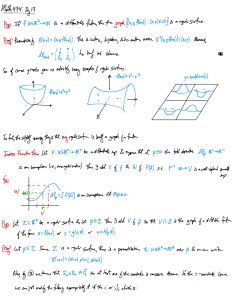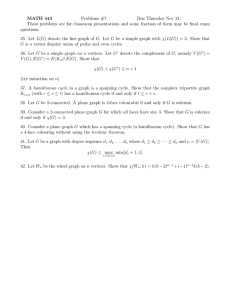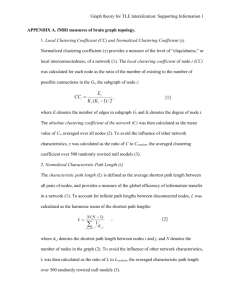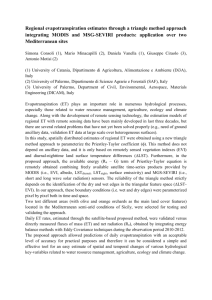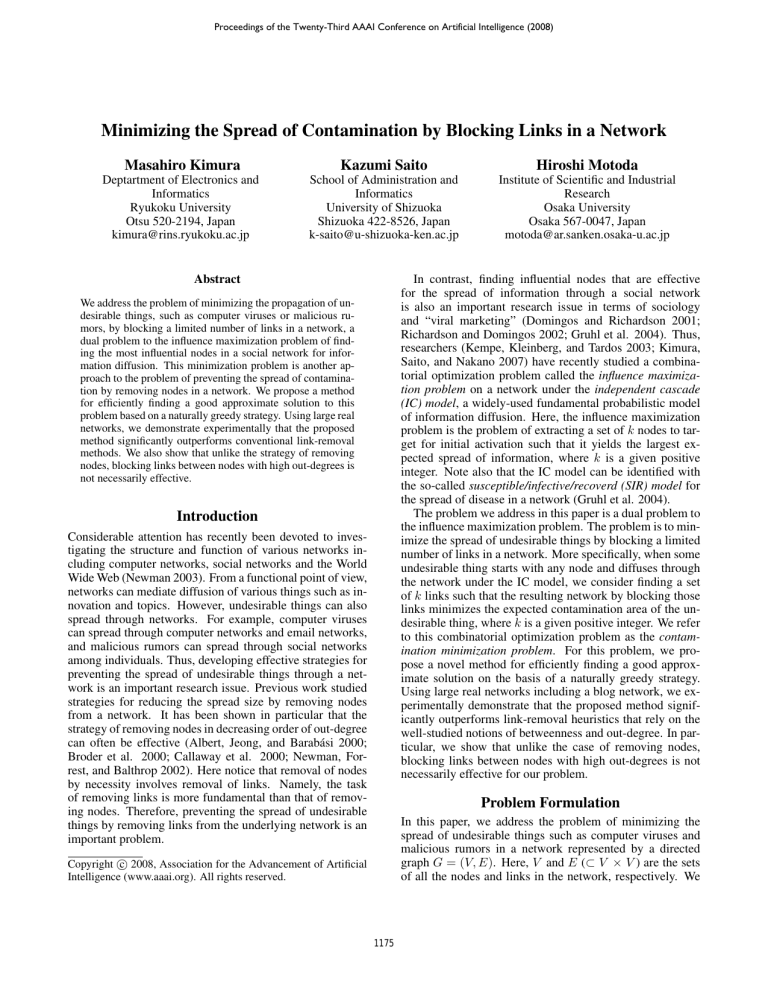
Proceedings of the Twenty-Third AAAI Conference on Artificial Intelligence (2008)
Minimizing the Spread of Contamination by Blocking Links in a Network
Masahiro Kimura
Kazumi Saito
Hiroshi Motoda
Deptartment of Electronics and
Informatics
Ryukoku University
Otsu 520-2194, Japan
kimura@rins.ryukoku.ac.jp
School of Administration and
Informatics
University of Shizuoka
Shizuoka 422-8526, Japan
k-saito@u-shizuoka-ken.ac.jp
Institute of Scientific and Industrial
Research
Osaka University
Osaka 567-0047, Japan
motoda@ar.sanken.osaka-u.ac.jp
Abstract
In contrast, finding influential nodes that are effective
for the spread of information through a social network
is also an important research issue in terms of sociology
and “viral marketing” (Domingos and Richardson 2001;
Richardson and Domingos 2002; Gruhl et al. 2004). Thus,
researchers (Kempe, Kleinberg, and Tardos 2003; Kimura,
Saito, and Nakano 2007) have recently studied a combinatorial optimization problem called the influence maximization problem on a network under the independent cascade
(IC) model, a widely-used fundamental probabilistic model
of information diffusion. Here, the influence maximization
problem is the problem of extracting a set of k nodes to target for initial activation such that it yields the largest expected spread of information, where k is a given positive
integer. Note also that the IC model can be identified with
the so-called susceptible/infective/recoverd (SIR) model for
the spread of disease in a network (Gruhl et al. 2004).
The problem we address in this paper is a dual problem to
the influence maximization problem. The problem is to minimize the spread of undesirable things by blocking a limited
number of links in a network. More specifically, when some
undesirable thing starts with any node and diffuses through
the network under the IC model, we consider finding a set
of k links such that the resulting network by blocking those
links minimizes the expected contamination area of the undesirable thing, where k is a given positive integer. We refer
to this combinatorial optimization problem as the contamination minimization problem. For this problem, we propose a novel method for efficiently finding a good approximate solution on the basis of a naturally greedy strategy.
Using large real networks including a blog network, we experimentally demonstrate that the proposed method significantly outperforms link-removal heuristics that rely on the
well-studied notions of betweenness and out-degree. In particular, we show that unlike the case of removing nodes,
blocking links between nodes with high out-degrees is not
necessarily effective for our problem.
We address the problem of minimizing the propagation of undesirable things, such as computer viruses or malicious rumors, by blocking a limited number of links in a network, a
dual problem to the influence maximization problem of finding the most influential nodes in a social network for information diffusion. This minimization problem is another approach to the problem of preventing the spread of contamination by removing nodes in a network. We propose a method
for efficiently finding a good approximate solution to this
problem based on a naturally greedy strategy. Using large real
networks, we demonstrate experimentally that the proposed
method significantly outperforms conventional link-removal
methods. We also show that unlike the strategy of removing
nodes, blocking links between nodes with high out-degrees is
not necessarily effective.
Introduction
Considerable attention has recently been devoted to investigating the structure and function of various networks including computer networks, social networks and the World
Wide Web (Newman 2003). From a functional point of view,
networks can mediate diffusion of various things such as innovation and topics. However, undesirable things can also
spread through networks. For example, computer viruses
can spread through computer networks and email networks,
and malicious rumors can spread through social networks
among individuals. Thus, developing effective strategies for
preventing the spread of undesirable things through a network is an important research issue. Previous work studied
strategies for reducing the spread size by removing nodes
from a network. It has been shown in particular that the
strategy of removing nodes in decreasing order of out-degree
can often be effective (Albert, Jeong, and Barabási 2000;
Broder et al. 2000; Callaway et al. 2000; Newman, Forrest, and Balthrop 2002). Here notice that removal of nodes
by necessity involves removal of links. Namely, the task
of removing links is more fundamental than that of removing nodes. Therefore, preventing the spread of undesirable
things by removing links from the underlying network is an
important problem.
Problem Formulation
In this paper, we address the problem of minimizing the
spread of undesirable things such as computer viruses and
malicious rumors in a network represented by a directed
graph G = (V, E). Here, V and E (⊂ V × V ) are the sets
of all the nodes and links in the network, respectively. We
Copyright c 2008, Association for the Advancement of Artificial
Intelligence (www.aaai.org). All rights reserved.
1175
Proposed Method
assume the IC model to be a mathematical model for the
diffusion process of some undesirable thing in the network,
and investigate the contamination minimization problem on
G. We call nodes active if they have been contaminated by
the undesirable thing.
We propose a method for efficiently finding a good approximate solution to the contamination minimization problem
on graph G = (V, E). Let k be the number of links to be
blocked in this problem.
Independent Cascade Model
Geedy Algorithm
We define the IC model on graph G according to the work
of Kempe, Kleinberg, and Tardos (2003).
In the IC model, the diffusion process unfolds in discrete
time-steps t ≥ 0, and it is assumed that nodes can switch
their states only from inactive to active, but not from active
to inactive. Given an initial active node v, we assume that
the node v has first become active at time-step 0, and all the
other nodes are inactive at time-step 0. We specify a real
value p with 0 < p < 1 in advance. Here, p is referred
to as the propagation probability through a link. The diffusion process proceeds from the initial active node v in the
following way. When a node u first becomes active at timestep t, it is given a single chance to activate each currently
inactive child node w, and succeeds with probability p. If u
succeeds, then w will become active at time-step t + 1. If
multiple parent nodes of w first become active at time-step
t, then their activation attempts are sequenced in an arbitrary order, but all performed at time-step t. Whether or not
u succeeds, it cannot make any further attempts to activate
w in subsequent rounds. The process terminates if no more
activations are possible.
For an initial active node v, let σ(v; G) denote the expected number of active nodes at the end of the random process of the IC model on G. We call σ(v; G) the influence
degree of node v in graph G.
We approximately solve the contamination minimization
problem on G = (V, E) by the following greedy algorithm:
1. Set D0 ← ∅.
2. Set E0 ← E.
3. Set G0 ← G.
4. for i = 0 to k − 1 do
5. Choose a link e∗ ∈ Ei minimizing c(Gi (e)), (e ∈ Ei ).
6. Set Di+1 ← Di ∪ {e∗ }.
7. Set Ei+1 ← Ei \ {e∗ }.
8. Set Gi+1 ← (V, Ei+1 ).
9. end for
Here, Dk is the set of links blocked, and represents the approximate solution obtained by this algorithm. Gk is the
graph constructed by blocking Dk in graph G, that is, Gk =
G(Dk ).
To implement this greedy algorithm, we need a method
for calculating {c(Gi (e)); e ∈ Ei } in Step 5 of the algorithm. However, the IC model is a stochastic process model,
and it is an open question to exactly calcluate influence degrees by an efficient method (Kempe, Kleinberg, and Tardos 2003). Therefore, we develop a method for estimating
{c(Gi (e)); e ∈ Ei }.
Kimura, Saito, and Nakano (2007) presented the bond
percolation method that efficiently estimates the influence
degrees {σ(v; G̃); v ∈ V } for any directed graph G̃ =
(V, Ẽ). Thus, we can estimate c(Gi (e)) for each e ∈ Ei
by straightforwardly applying the bond percolation method.
However, |Ei | becomes very large for a large network unless i is very large. Therefore, we propose a method that can
estimate {c(Gi (e)); e ∈ Ei } in a more efficient manner on
the basis of the bond percolation method.
Contamination Minimization Problem
Now, we give a mathematical definition of the contamination
minimization problem on graph G = (V, E). For preventing the undesirable thing from spreading through the network under the IC model, we aim to minimize the expected
contamination area (that is, the expected number of active
nodes) by appropriately removing a fixed number of links.
First, we define the contamination degree c(G) of graph
G as the average of influence degrees of all the nodes in G,
that is,
1 X
c(G) =
σ(v; G).
(1)
|V |
Bond Percolation Method
First, we revisit the bond percolation method (Kimura, Saito,
and Nakano 2007). Here, we consider estimating the influence degrees {σ(v; Gi ); v ∈ V } for the IC model with propagation probability p in graph Gi = (V, Ei ).
It is known that the IC model is equivalent to the bond
percolation process that independently declares every link
of Gi to be “occupied” with probability p (Newman 2003).
Let M be a sufficiently large positive integer. We perform
the bond percolation process M times, and sample a set of
M graphs constructed by the occupied links,
{Gi m = (V, Ei m ); m = 1, · · · , M } .
Then, we can approximate the influence degree σ(v; Gi ) by
v∈V
Here, |A| stands for the number of elements of a set A. For
any link e ∈ E, let G(e) denote the graph (V , E \ {e}).
We refer to G(e) as the graph constructed by blocking e in
G. Similarly, for any D ⊂ E, let G(D) denote the graph
(V , E \ D). We refer to G(D) as the graph constructed by
blocking D in G. We define the contamination minimization
problem on graph G as follows: Given a positive integer k
with k < |E|, find a subset D∗ of E with |D∗ | = k such that
c(G(D∗ )) ≤ c(G(D)) for any D ⊂ E with |D| = k.
For a large network, any straightforward method for exactly solving the contamination minimization problem suffers from combinatorial explosion. Therefore, we consider
approximately solving the problem.
σ(v; Gi ) ≃
1176
M
1 X
|F(v; Gi m )| .
M m=1
Experimental Evaluation
Here, for any directed graph G̃ = (V, Ẽ), F(v; G̃) denotes
the set of all the nodes that are reachable from node v in the
graph. We say that node u is reachable from node v if there
is a path from u to v along the links in the graph. Let
[
V =
S(u; Gi m )
Using two large real networks, we experimentally evaluated
the performance of the proposed method.
Network Datasets
First, we employed a trackback network of blogs because
a piece of information can propagate from one blog author to another blog author through a trackback. Since
bloggers discuss various topics and establish mutual communications by putting trackbacks on each other’s blogs,
we regarded a link created by a trackback as a biderectional link for simplicity. By tracing up to ten steps
back in the trackbacks from the blog of the theme “JR
Fukuchiyama Line Derailment Collision” in the site “goo”
(http://blog.goo.ne.jp/usertheme/), we collected a large connected trackback network in May, 2005.
This network was a directed graph of 12, 047 nodes and
79, 920 links. We refer to this network data as the blog network.
Next, we employed a network of people that was derived from the “list of people” within Japanese Wikipedia.
Specifically, we extracted the maximal connected component of the undirected graph obtained by linking two people in the “list of people” if they co-occur in six or more
Wikipedia pages, and constructed a directed graph regarding those undirected links as bidirectional ones. We refer
to this network data as the Wikipedia network. Here, the
total numbers of nodes and directed links were 9, 481 and
245, 044, respectively.
Note here that these two networks are strongly connected.
u∈U(Gi m )
be the strongly connected component (SCC) decomposition
of graph Gi m , where S(u; Gi m ) denotes the SCC of Gi m
that contains node u, and U(Gi m ) stands for a set of all the
representative nodes for the SCCs of Gi m . The bond percolation method performs the SCC decomposition of each
Gi m , and estimates all the influence degrees {σ(v; Gi );
v ∈ V } in Gi as follows:
σ(v; Gi ) =
M
1 X
|F(u; Gi m )| , (v ∈ S(u; Gi m )) , (2)
M m=1
where u ∈ U(Gi m ).
Estimation Method
We are now in a position to give a method for efficiently
estimating {c(Gi (e)); e ∈ Ei } in Step 5 of the greedy algorithm. We develop such an estimation method on the basis
of the bond percolation method.
For any directed graph G̃ = (V, Ẽ), we define ϕ(G̃) by
1 X
ϕ(G̃) =
F(v; G̃) .
(3)
|V |
v∈V
Experimental Settings
Using the bond percolation method, we consider estimating
the contamination degree c(Gi ) of the graph Gi = (V, Ei ).
Then, by Equations (1), (2) and (3), we can estimate c(Gi )
as
M
1 X
ϕ(Gi m ).
(4)
c(Gi ) =
M m=1
The IC model has the propagation probability p as a parameter. So we determine the typical values of p for the blog
and Wikipedia networks, and use them in the experiments.
Let us consider the bond percolation process corresponding
to the IC model with propagation probability p in graph G
= (V, E). Let S be the expected fraction of the maximal
SCC in the network constructed by occupied links. S is a
function of p, and as the value of p decreases, the value of
S decreases. In other words, as the value of p decreases, the
original graph G gradually fragments into small clusters under the corresponding bond percolation process. Figures 1
and 2 show the network fragmentation curves for the blog
and Wikipedia networks, respectively. Here, we estimated
S as follows:
M
1 X
S=
max |S(u; Gi m )|,
M m=1 u∈U(Gi m )
Here, note that ϕ(Gi m ) is calculated by
X
1
|F(u; Gi m )| |S(u; Gi m )| . (5)
ϕ(Gi m ) =
|V |
m
u∈U (Gi
)
We assume that M is sufficiently large. Then, by the independence of the bond percolation process, we can estimate
c(Gi (e)) for every e ∈ Ei as
X
1
c(Gi (e)) =
ϕ(Gi m ),
(6)
|Mi (e)|
where M = 10000. We focus on the point p∗ at which the
average rate dS/dp of change of S attains the maximum, and
regard it as the typical value of p for the network. Note that
p∗ is a critical point of dS/dp, and defines one of the features
intrinsic to the network. From Figures 1 and 2, we estimated
p∗ to be p∗ = 0.2 for the blog network and p∗ = 0.03 for
the Wikipedia network.
For the proposed method, we need to specify the number M of performing the bond percolation process. In the
experiments, we used M = 10000.
m∈Mi (e)
where Gi m = (V, Ei m ), and
Mi (e) = {m ∈ {1, · · · , M }; e ∈
/ Ei m } .
We efficiently estimate {c(Gi (e)); e ∈ Ei } by Equations (5)
and (6) without applying the bond percolation method for
every e ∈ Ei . Namely, the proposed method can achieve a
great deal of reduction in computational cost compared with
the coventional bond percolation method.
1177
1
1
fraction of maximal SCC S
fraction of maximal SCC S
0.9
0.8
0.7
0.6
0.5
0.4
0.3
0.2
0
0
0.2
0.4
0.6
0.8
1
0.4
0.3
0.2
0.1
0.1
0
0
0.5
0.2
0.4
0.6
0.8
0
0.01
1
propagation probability p
0.03
0.05
0.07
0.09
propagation probability p
Figure 1: Fragmentation of the blog network for the IC
model. The fraction S of the maximal SCC as a function
of the propagation probablity p.
Figure 2: Fragmentation of the Wikipedia network for the
IC model. The fraction S of the maximal SCC as a function
of the propagation probablity p. The upper and lower frames
show the network fragmentation curves for the whole range
of p and the range of 0.01 ≤ p ≤ 0.09, respectively.
Comparison Methods
We compared the proposed method with two heuristics
based on the well-studied notions of betweenness and outdegree in the field of complex network theory, as well as the
crude baseline of blocking links at random. We refer to the
method of blocking links uniformly at random as the random method.
The betweenness score bG̃ (e) of a link e in a directed
graph G̃ = (V, Ẽ) is defined as follows:
bG̃ (e) =
the spread of contamination in the network. Therefore, we
apply the method of Newman and Girvan (2004) to the contamination minimization problem. We refer to this method
as the betweenness method.
On the other hand, previous work has shown that simply
removing nodes in order of decreasing out-degrees works
well for preventing the spread of contamination in most real
networks (Albert, Jeong, and Barabási 2000; Broder et al.
2000; Callaway et al. 2000; Newman, Forrest, and Balthrop
2002). Here, the out-degree d(v) of a node v means the
number of outgoing links from the node v. Thus, blocking
links between nodes with high out-degrees looks promising
for the contamination minimization problem. Therefore, as
a comparsion method, we employ the method of recursively
blocking links e = [u, v] from u to v in decreasing order of
their scores d(e),
X n (e; u, v)
G̃
,
NG̃ (u, v)
u,v∈V
where NG̃ (u, v) denotes the number of the shortest paths
from node u to node v in G̃, and nG̃ (e; u, v) denotes
the number of those paths that pass e. Here, we set
nG̃ (e; u, v)/NG̃ (u, v) = 0 if NG̃ (u, v) = 0. Newman and
Girvan (2004) successfully extracted community structure in
a network using the following link-removal algorithm based
on betweeness:
d(e) = d(u) d(v).
We refer to this method as the out-degree method.
1. Calculate betweenness scores for all links in the network.
Experimental Results
2. Find the link with the highest score and remove it from
the network.
We evaluated the performance of the proposed method and
compare it with that of the betweenness, out-degree and
random methods. Clearly, the performance of a method
for solving the contamination minimization problem can be
evaluated in terms of contamination degree c. We used the
value of c (see Equations (4) and (5)) that is estimated by the
bond percolation method with M = 10000.
Figures 3 and 4 show the contamination degree c of the
resulting network as a function of the number k of links
blocked for the blog network, where the circles, triangles,
diamonds and squares indicate the results for the proposed,
betweenness, out-degree and random methods, respectively.
3. Recalculate betweenness scores for all remaining links.
4. Repeat from Step 2.
In particular, the notion of betweenness can be interpreted in
terms of signals traveling through a network. If signals travel
from source nodes to destination nodes along the shortest
paths in a network, and all nodes send signals at the same
constant rate to all others, then the betweenness score of a
link is a measure of the rate at which signals pass along the
link. Thus, we naively expect that blocking the links with the
highest betweenness score can be effective for preventing
1178
1000
1000
proposed
betweenness
contamination degree c
contamination degree c
950
900
850
800
750
700
650
900
800
700
proposed (k = 100)
out−degree
random
600
500
600
550
0
20
40
60
80
400
100
2
10
number of links blocked k
3
10
4
10
number of links blocked k
Figure 3: Performance comparison between the proposed
and betweenness methods in the blog network for the IC
model with p = 0.2.
Figure 4: Performance comparison of the proposed method
for k = 100 with the out-degree and random methods in the
blog network for the IC model with p = 0.2.
In Figure 4, the dashed line indicates the contamination degree of the network obtained by the proposed method for
k = 100. From Figures 3 and 4, we first see that the
proposed method outperformed the betweenness, out-degree
and random methods for the blog network. By taking into
account the definition (1) of contamination degree, we can
mention from Figure 3 that the proposed method decreased
the expected number of nodes contaminated from about 980
nodes to about 580 nodes by blocking appropriate 100 links
for the blog network. Here note that blocking 100 links
means blocking about 0.13% of the links in the blog network. Thus, we find from Figure 3 that by appropriately
blocking about 0.13% of the links in the blog network, the
proposed and betweenness methods decreased contamination degree by about 41% and 30%, respectively. Hence,
we can deduce that the proposed method was effective, and
also outperformed the betweennes method by over 10% at
k = 100 for the blog network. Moreover, we find from Figure 4 that blocking 100 links by using the proposed method
was the same as blocking over 10000 links by using the outdegree and random methods for the blog network in effect.
Namely, we can deduce that the proposed method was 100
times more effective than the out-degree and random methods at k = 100 for the blog network.
Figures 5 and 6 display the contamination degree c of the
resulting network as a function of the number k of links
blocked for the Wikipedia network. Here, as in Figures 3
and 4, the circles, triangles, diamonds and squares indicate
the results for the proposed, betweenness, out-degree and
random methods, respectively. In Figure 6, the dashed line
indicates the contamination degree of the network obtained
by the proposed method for k = 300. We also see from
Figures 5 and 6 that the proposed method outperformed
the betweenness, out-degree and random methods for the
Wikipedia network. In particualr, we observe from Figure 5
that as the value of k increased, the performance difference
between the proposed and betweenness methods gradually
increased. Note here that blocking 300 links means blocking
about 0.12% of the links in the Wikipedia network. Thus,
we find from Figure 5 that by appropriately blocking about
0.12% of the links in the Wikipedia network, the proposed
and betweenness methods decreased contamination degree
by about 26% and 16%, respectively. Hence, we can deduce that the proposed method was effective, and also outperformed the betweennes method by about 10% at k = 300
for the Wikipedia network. Moreover, we find from Figure 6 that blocking 300 links by using the proposed method
was the same as blocking about 30000 links by using the
out-degree and random methods for the Wikipedia network.
Namely, we can deduce that the proposed method was effective about 100 times as much as the out-degree and random
methods at k = 300 for the Wikipedia network.
These results imply that the proposed method works effectively as expected, and significantly outperforms the conventional link-removal heuristics, that is, the betweenness,
out-degree and random methods. This shows that a significantly better link-blocking strategy for reducing the spread
size of contamination can be obtained by explicitly incorporating the diffusion dynamics of contamination in a network, rather than relying solely on structual properties of
the graph.
We note from Figures 4 and 6 that the out-degree method
was almost the same as or worse than the random method
in performance. In the task of removing nodes from a network, the out-degree heuristic has been effective since many
links can be blocked at the same time by removing nodes
with high out-degrees. However, we find that in the task of
blocking a limited number of links, the strategy of blocking
links between nodes with high out-degrees is not necessarily
effective.
1179
420
420
proposed
betweenness
400
contamination degree c
contamination degree c
400
380
360
340
320
360
340
proposed (k = 300)
out−degree
random
320
300
300
280
0
380
50
100
150
200
250
280
300
2
10
number of links blocked k
3
10
4
10
number of links blocked k
Figure 5: Performance comparison between the proposed
and betweenness methods in the Wikipedia network for the
IC model with p = 0.03.
Figure 6: Performance comparison of the proposed method
for k = 300 with the out-degree and random methods in the
Wikipedia network for the IC model with p = 0.03.
Conclusion
Callaway, D. S.; Newman, M. E. J.; Strogatz, S. H.; and
Watts, D. J. 2000. Network robustness and fragility:
Percolation on random graphs. Physical Reveiw Letters
85:5468–5471.
Domingos, P., and Richardson, M. 2001. Mining the network value of customers. In Proceedings of the 7th ACM
SIGKDD International Conference on Knowledge Discovery and Data Mining, 57–66.
Gruhl, D.; Guha, R.; Liben-Nowell, D.; and Tomkins, A.
2004. Information diffusion through blogspace. In Proceedings of the 13th International World Wide Web Conference, 107–117.
Kempe, D.; Kleinberg, J.; and Tardos, E. 2003. Maximizing the spread of influence through a social network. In
Proceedings of the 9th ACM SIGKDD International Conference on Knowledge Discovery and Data Mining, 137–
146.
Kimura, M.; Saito, K.; and Nakano, R. 2007. Extracting influential nodes for information diffusion on a social
network. In Proceedings of the 22nd AAAI Conference on
Artificial Intelligence, 1371–1376.
Newman, M. E. J., and Girvan, M. 2004. Finding and evaluating community structure in networks. Physical Review
E 69:026113.
Newman, M. E. J.; Forrest, S.; and Balthrop, J. 2002. Email
networks and the spread of computer viruses. Physical Review E 66:035101.
Newman, M. E. J. 2003. The structure and function of
complex networks. SIAM Review 45:167–256.
Richardson, M., and Domingos, P. 2002. Mining
knowledge-sharing sites for viral marketing. In Proceedings of the 8th ACM SIGKDD International Conference on
Knowledge Discovery and Data Mining, 61–70.
In an attempt to minimize the spread of undesirable things
by blocking links in a network, we have considered the contamination minimization problem, a dual problem to the influence maximization problem for social networks. This
minimization problem is another approach to the problem of
preventing the spread of contamination by removing nodes
in a network, We have proposed a novel method for efficiently finding a good approximate solution to this problem
on the basis of the greedy algorithm and the bond percolation method. Using large-scale blog and Wikipedia networks, we have experimentally demonstrated that the proposed method effectively works, and also significantly outperforms the conventional link-removal heuristics based on
the betweenness and out-degree. Moreover, we have found
that unlike the task of removing nodes, the strategy of blocking links between nodes with high out-degrees is not necessarily effective for our problem.
Acknowledgments
This work was partly supported by Asian Office of
Aerospace Research and Development, Air Force Office of
Scientific Research, U.S. Air Force Research Laboratory under Grant No. AOARD-08-4027.
References
Albert, R.; Jeong, H.; and Barabási, A.-L. 2000. Error and
attack tolerance of complex networks. Nature 406:378–
382.
Broder, A.; Kumar, R.; Maghoul, F.; Raghavan, P.; Rajagopalan, S.; Stata, R.; Tomkins, A.; and Wiener, J. 2000.
Graph structure in the web. In Proceedings of the 9th International World Wide Web Conference, 309–320.
1180

